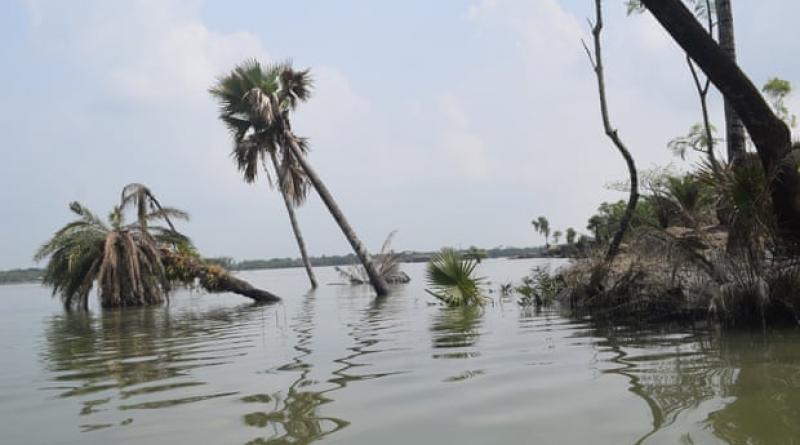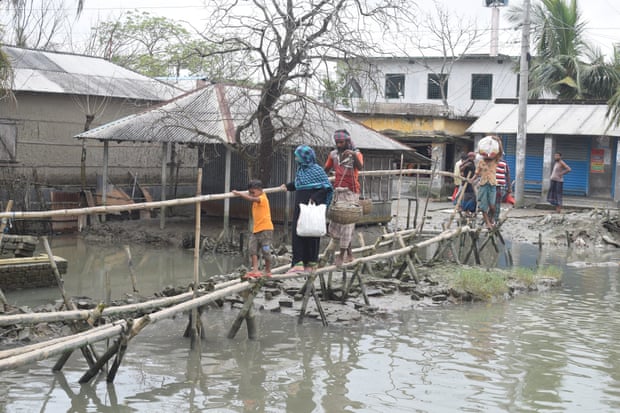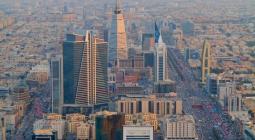'It's over for us': how extreme weather is emptying Bangladesh's villages.

The frequency of natural disasters is making life in rural areas increasingly difficult, pushing inhabitants into city slums.
The house Faruk Hossain grew up in has, for the last six months, resisted being claimed by the river, as the rest of the village already has been.
But slowly, as the waters have failed to seep away, he has come to accept that the family house has become uninhabitable. Like other villages nearby, Chakla in Bangladesh’s Satkhira district has not re-emerged from the flooding caused by Super-cyclone Amphan, which battered the south of the country in late May,
Hossain, 56, has begun preparing to leave, abandoning his livelihood as a farmer, to rent a small place in Khulna, the closest big city.
“I’m leaving my father’s address forever,” he says. “All my relatives including my four brothers have lived here for several decades. Frequent natural disasters prevented us from living in our own homes. The other brothers left long ago. I was the last one.
“I lived in my father’s address for about six months with great difficulty but the last traces of the house are gradually being swallowed up by the river. In the end, I failed to keep hold of it.”
Last month, Bangladesh marked 50 years since Cyclone Bhola, which killed at least 300,000 people. Although the death tolls have reduced in recent times, the frequency of natural disasters makes it increasingly difficult for villages to recover.
The coastal areas of Satkhira and Khulna districts are full of people made homeless and stranded since the embankments of local rivers burst, having been worn away by repeated storms. In Khulna’s Pratapnagar area, all 18 villages remain under water.
Bangladesh’s disaster management department has said 300,000 people have been affected by the flooding. About 50,000 people are still displaced, according to a survey of families by Bangladeshi NGO Local Environment Development and Agricultural Research Society.

They have spent the months since Amphan living on government land, camped out by the riverside or near roads or in cyclone shelters. Exasperated, some have gone to nearby villages or to cities.
Others have moved to patches of dry land, building new huts on stilts, but, in a year when the Covid-19 pandemic cost migrant workers jobs in cities or abroad, Amphan has further damaged economic life for people on the margins. Two rice planting seasons and harvests have already passed.
Communal ponds that provide villages sustainable access to fish have also been destroyed, as have the shrimp farms that were promoted as a source of employment, washed away in the floodwater. Drivers transporting crops to market have sold their vehicles and turned to trying to make a living in boats.
“I used to work in agriculture. I used to plant paddy and had a very good rice yield,” says Shahjahan Moral, 45, from Kurikahunia village. “My paddy land is now under water. I now sail my boat through the paddy fields. I take passengers from one side to the other and get 100 [£0.88] to 150 taka. The family can’t survive on this little income.’’
Alexandra Bilak, director of the Internal Displacement Monitoring Centre, says interaction between the pandemic and the cyclone have created a complex crisis.
“It will be easier to find a sustainable solution if the displacement information is available properly. Along with this, initiatives have to be taken to create stable housing. We have to build sustainable urbanisation. The risk of displacement can be significantly reduced through ecosystem management,’ she says.
Communal ponds that provide villages sustainable access to fish have also been destroyed, as have the shrimp farms that were promoted as a source of employment, washed away in the floodwater. Drivers transporting crops to market have sold their vehicles and turned to trying to make a living in boats.
“I used to work in agriculture. I used to plant paddy and had a very good rice yield,” says Shahjahan Moral, 45, from Kurikahunia village. “My paddy land is now under water. I now sail my boat through the paddy fields. I take passengers from one side to the other and get 100 [£0.88] to 150 taka. The family can’t survive on this little income.’’
Alexandra Bilak, director of the Internal Displacement Monitoring Centre, says interaction between the pandemic and the cyclone have created a complex crisis.
“It will be easier to find a sustainable solution if the displacement information is available properly. Along with this, initiatives have to be taken to create stable housing. We have to build sustainable urbanisation. The risk of displacement can be significantly reduced through ecosystem management,’ she says.

Humayun Kabir, head of the local council in the Koira Sadar area, says flood embankments built in the 1960s have been worn away after repeated storms but the government has not responded to requests for repairs.
“I have been facing natural disasters since 1986. Everything is over for us. A natural disaster comes and we become destitute,” says Abdus Sattar Gazi from Kurikahunia village.
The house he and his wife, Zahera Khatun, live in, is now directly next to the river, which merged with a canal during Amphan and has not receded.
The flood defences have been swallowed up in the new bigger river and they look out at it in concern, watching the water level whenever it rains.
“Each time it takes a few years of work to return to my normal life and then comes another natural disaster. This is how life goes. We would not have had this problem if there was a strong embankment.’’
In the villages that lay in Amphan’s path, people complain about embankments that went unrepaired after similar cyclones, like Sidr and Aila, which killed thousands of people in 2007 and 2009.
According to Abul Khair, a senior engineer at Satkhira’s Water Development Board, applications for funding have never been approved, forcing them to make repairs only from limited annual budgets.
The long-term effects of flooding are pushing Bangladesh’s rural populations into already crowded cities, expanding their slums.

Saleemul Huq, director of the International Centre for Climate Change and Development, says Bangladesh’s success in saving lives by managing the natural disasters themselves needs to be matched with better support afterwards.
“We are able to successfully evacuate millions of people and it can prevent loss of life but people are still losing their homes, land and livelihoods. There is a lack of support after the cyclone,” he says.
“Unfortunately, with climate change and rising sea levels, people in the lower coastal districts of Bangladesh will gradually lose their livelihoods as fishermen and farmers, They will be forcibly displaced. This needs to be actively addressed by both the national government and the international community.’’
16 December 2020
The Guardian




